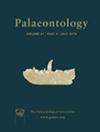Phylogenetic structure of the extinction and biotic factors explaining differential survival of terrestrial notosuchians at the Cretaceous–Palaeogene crisis
IF 2.3
2区 地球科学
Q1 PALEONTOLOGY
引用次数: 0
Abstract
Although the clade Crocodylomorpha is represented by few extant species (Crocodylia), it has a rich fossil record. Hundreds of species, adapted to terrestrial, semi‐aquatic and marine environments, have existed over more than 200 million years. Numerous studies have attempted to characterize the factors driving the diversification and extinction events of Crocodylomorpha, resulting in ambiguous and even contradictory conclusions, which points to the need for phylogenetically and temporally smaller‐scaled studies. Here, we focus on differential survival at the Cretaceous–Palaeogene (K–Pg) crisis of Notosuchia, a diverse clade of mostly terrestrial Crocodylomorpha that achieved great diversity during the Cretaceous. More precisely, we tested the effect of body size and palaeotemperatures on notosuchian survival probability during the K–Pg crisis as well as the effect of diet on the evolution of their body size. We find that Notosuchia showed an evolutionary trend towards larger body sizes through time, associated with a shift from an omnivorous to a carnivorous diet. This may explain why sebecids were the only notosuchians to survive the K–Pg crisis. We also corroborate the conclusions of previous studies that detected a Lagerstätten effect occurring in the Adamantina Formation (Upper Cretaceous, Brazil, Bauru Group). This work confirms the value of more finely‐scaled macroevolutionary studies for understanding the history of a rich and complex group such as Crocodylomorpha.白垩纪-古近纪危机时期陆生野鸡灭绝的系统发育结构及生物因素解释
虽然鳄鱼进化门(Crocodylomorpha)的现存物种(Crocodylia)很少,但它有丰富的化石记录。数百种适应陆地、半水生和海洋环境的物种已经存在了2亿多年。许多研究试图描述鳄鱼的多样化和灭绝事件的驱动因素,导致模棱两可甚至相互矛盾的结论,这表明需要进行系统发育和时间上较小规模的研究。在这里,我们关注的是Notosuchia在白垩纪-古近纪(K-Pg)危机中的差异生存,Notosuchia是一个多样化的分支,主要是陆生鳄鱼,在白垩纪期间实现了巨大的多样性。更准确地说,我们测试了在K-Pg危机期间,体型和古温度对nottosuchian生存概率的影响,以及饮食对其体型进化的影响。我们发现,随着时间的推移,Notosuchia显示出一种体型变大的进化趋势,这与从杂食性饮食向食肉性饮食的转变有关。这也许可以解释为什么在K-Pg危机中,sebecids是唯一存活下来的非此类药物。我们还证实了先前研究的结论,即在Adamantina组(上白垩纪,巴西,Bauru组)检测到Lagerstätten效应。这项工作证实了更精细尺度的宏观进化研究对于理解鳄形目这样丰富而复杂的类群的历史的价值。
本文章由计算机程序翻译,如有差异,请以英文原文为准。
求助全文
约1分钟内获得全文
求助全文
来源期刊

Palaeontology
地学-古生物学
CiteScore
5.60
自引率
3.80%
发文量
43
审稿时长
6 months
期刊介绍:
Palaeontology publishes a wide variety of papers on palaeontological topics covering:
palaeozoology
palaeobotany
systematic studies
palaeoecology
micropalaeontology
palaeobiogeography
functional morphology
stratigraphy
taxonomy
taphonomy
palaeoenvironmental reconstruction
palaeoclimate analysis and biomineralization studies.
 求助内容:
求助内容: 应助结果提醒方式:
应助结果提醒方式:


